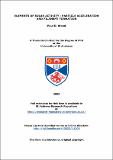Files in this item
Elements of solar activity : particle acceleration and filament formation
Item metadata
| dc.contributor.advisor | Neukirch, Thomas | |
| dc.contributor.author | Wood, Paul D. | |
| dc.coverage.spatial | iv, 181 p. | en_US |
| dc.date.accessioned | 2017-07-27T11:31:30Z | |
| dc.date.available | 2017-07-27T11:31:30Z | |
| dc.date.issued | 2005-01 | |
| dc.identifier.uri | https://hdl.handle.net/10023/11309 | |
| dc.description.abstract | This thesis studies the acceleration of particles to super-thermal energies in explosive solar events as well as the magnetic changes in connectivity that may be responsible for changes in the morphology of quiescent filaments. Firstly a review of some of the observations of solar flare dynamics is given, as well as an introduction to the competing theories attempting to explain both particle acceleration and filament formation. An explanation of the numerical FORTRAN code that is used to calculate the trajectories of particle distribution functions in prescribed electromagnetic fields is given. Examples of known fields are used to test the accuracy of the code and the simple example of the well-known Litvinenko current sheet field is investigated. The results of charged particle orbit calculations in prescribed electric and magnetic fields motivated by magnetic reconnection models are then presented. The electromagnetic fields are chosen to resemble a current sheet with a localised reconnection region. The dependence of the model on the important physical parameters is considered. An introduction to the mathematical formulation of a collapsing magnetic trap is given. The same numerical code is used to calculate single electron orbits in this more complicated time dependent electromagnetic field. Consideration of important previous work is given before describing the best attempts to model the movement of flare loops in a realistic fashion. Finally the process of flux cancellation and filament formation is studied using a range of data including ground-based Hα and SoHO MDI magnetograms. It is found that the cancellation occurs at the ends of Hα sections of the filament and is accompanied by a noticeable increase in the Hα intensity and linkage of the sections. Measurements of the amount of flux cancelled at each site show it is in agreement with an estimate of the axial flux contained in the filament. | en_US |
| dc.language.iso | en | en_US |
| dc.publisher | University of St Andrews | |
| dc.subject.lcc | QB526.P7W7 | |
| dc.subject.lcsh | Sun--Prominences | en |
| dc.subject.lcsh | Solar magnetic fields--Mathematical models | en |
| dc.subject.lcsh | Solar flares | en |
| dc.title | Elements of solar activity : particle acceleration and filament formation | en_US |
| dc.type | Thesis | en_US |
| dc.contributor.sponsor | Particle Physics and Astronomy Research Council (PPARC) | en_US |
| dc.type.qualificationlevel | Doctoral | en_US |
| dc.type.qualificationname | PhD Doctor of Philosophy | en_US |
| dc.publisher.institution | The University of St Andrews | en_US |
This item appears in the following Collection(s)
Items in the St Andrews Research Repository are protected by copyright, with all rights reserved, unless otherwise indicated.

